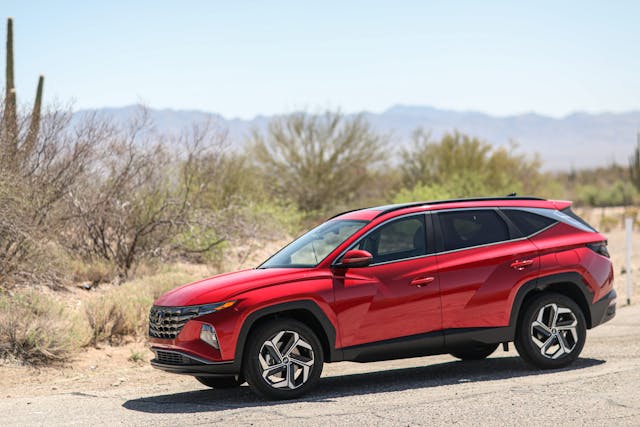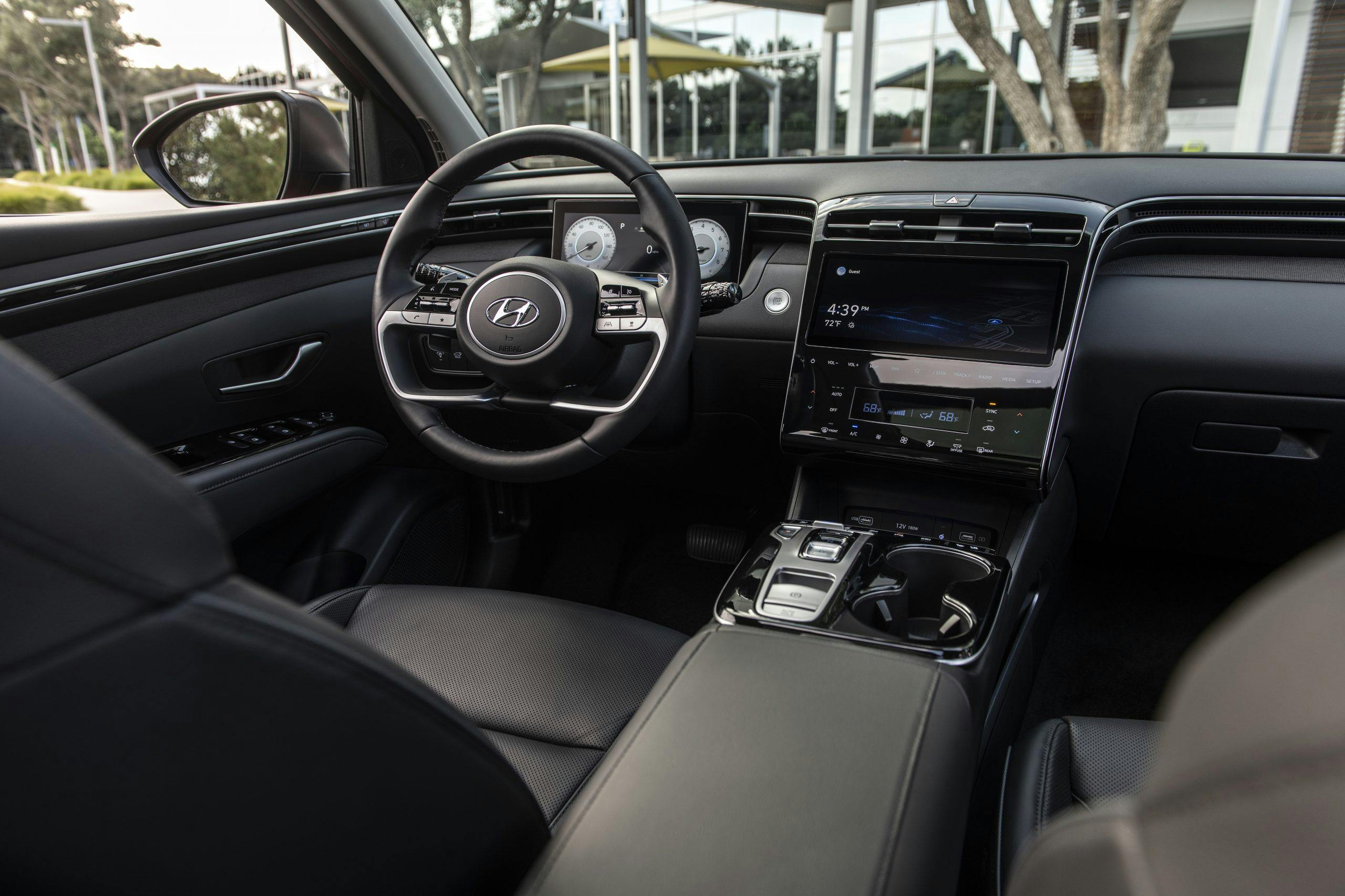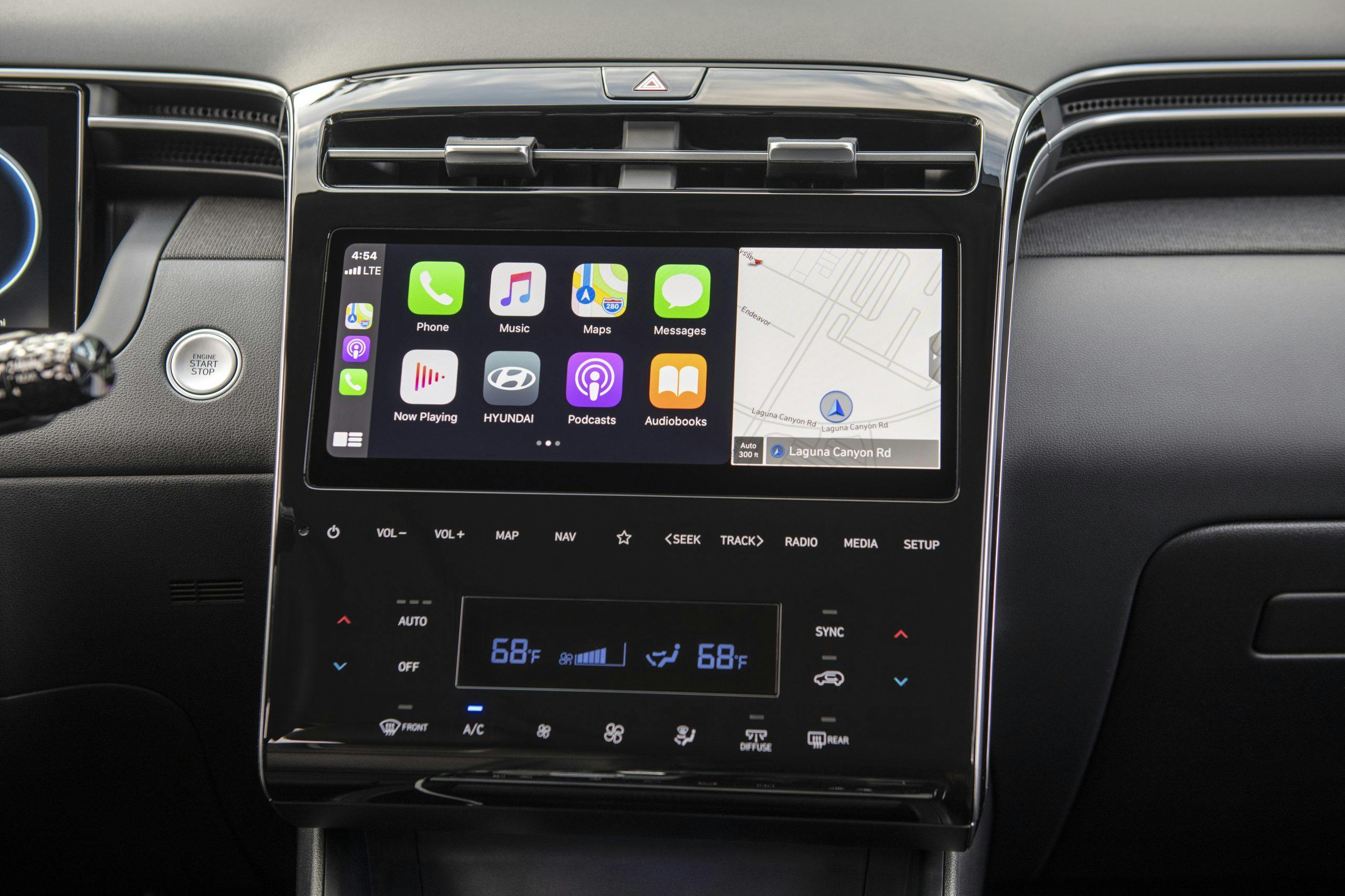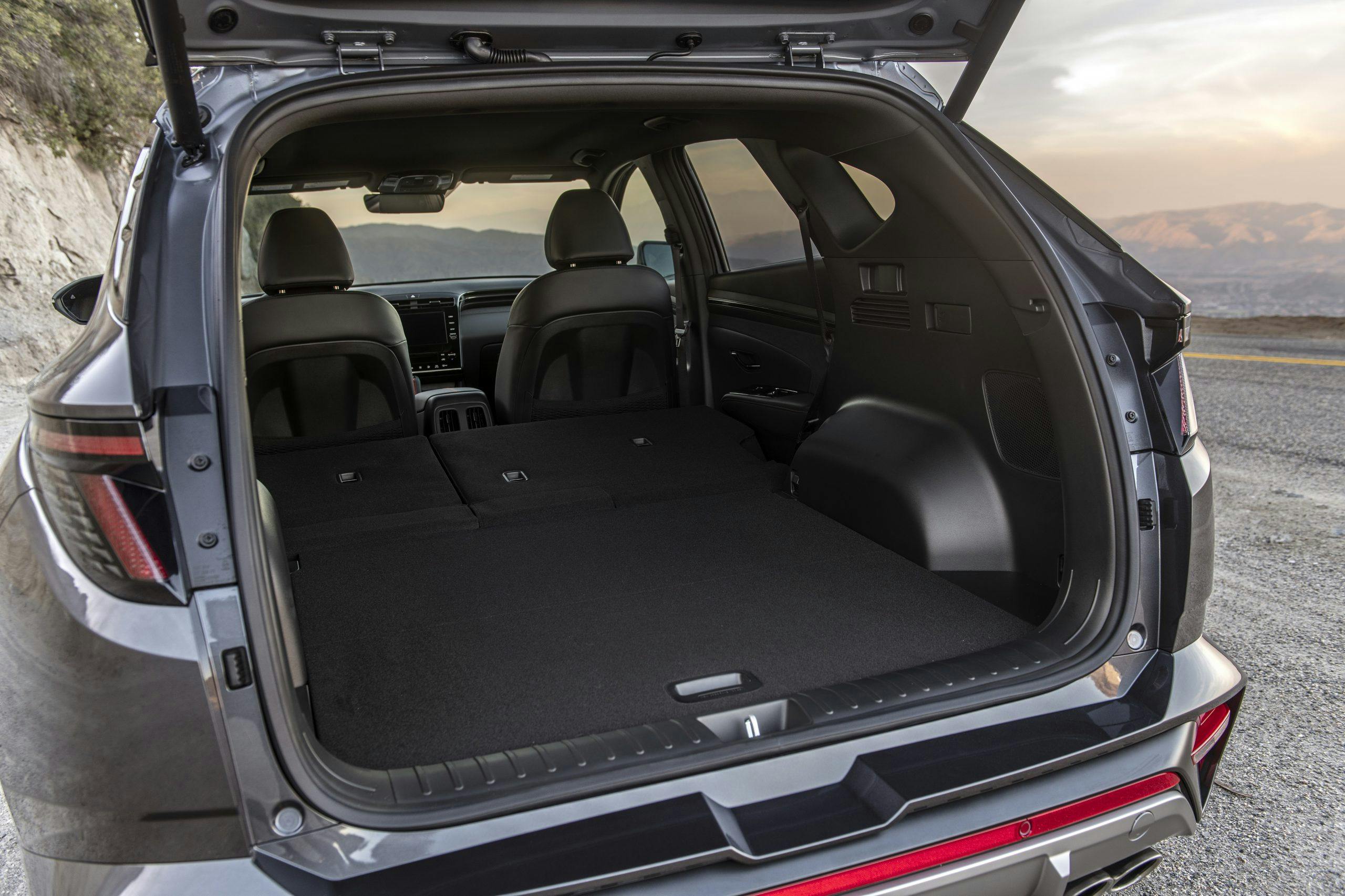Review: 2022 Hyundai Tucson
There’s a common saying in towns, cities, and regions all across the United States, and likely the world, that goes something like this, “If you don’t like the weather here, wait a minute and it will change.” You can say the same thing about Hyundai’s design language, as it seems the company has no qualms about sculpting entirely new looks for its brand. Lately, the Korean automaker has gone big with style ambition. Hyundai is out to snag buyers not just with a value proposition, but with sharp, striking lines. If you’ve wondered how the Honda Accord can look so vanilla when the Sonata is so adventurous, you’ll likely have the same reaction the first time you see a CR-V next to the the 2022 Tucson.
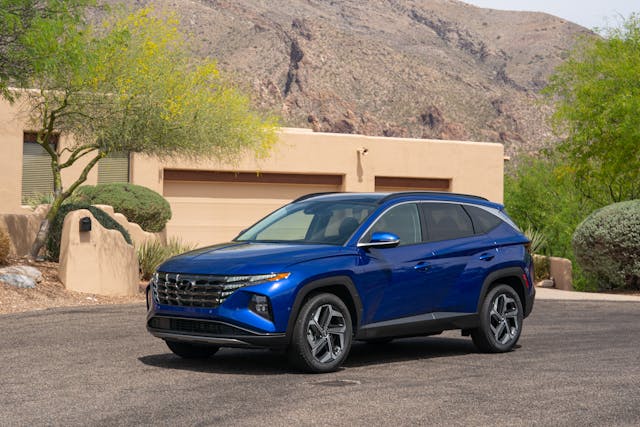
Like almost every other automaker doing business in America today, Hyundai’s top-selling model is a crossover. This very model, to be specific. Hyundai sold just shy of 126,000 Tucsons in 2020, compared to Honda’s 323,502 CR-Vs. Clearly this is not a market whose top priority is styling, but Hyundai is convinced that better looks, along with larger dimensions and better fuel efficiency, will up the Tucson’s game.
Most of our time behind the wheel of the 2022 Tucson (driving around Tucson, Arizona, naturally) was spent in a fully loaded Limited AWD model. It was equipped with a long list of standard features, including some interesting bits not found on any of the lower trim Tucsons, like the Blind-Spot View Monitor that has trickled down from Genesis. More on that later. The only option checked on our Limited test model was a set of carpeted floor mats ($169). That brought the total MSRP, including $1185 for destination, to $37,454. The Tucson Hybrid we tested, also a Limited, was similarly priced. It starts at $38,535 and, like all Tucson Hybrids, was equipped with all-wheel drive.

The previous-generation Tucson is not a bad-looking vehicle. If you were to critique its looks you could possibly say that it’s understated, but overall it’s a clean, uncluttered design that doesn’t look at all dated even after six years of production. In contrast, Hyundai’s new design language—visible on small cars like the Elantra as well as on the upcoming Santa Cruz pickup— adds facets to the fenders and flanks and looks purposeful, if a bit futuristic. Hyundai calls it a “mosaic,” and the Tucson is perhaps the best application of the aesthetic yet. Its wide grille hides running lights on the outer edges that become invisible when they’re turned off. When they’re on, the segmented lights provide a unique signature that will be instantly recognizable. While it certainly doesn’t look like anything else on the road, it’s not a wild departure. You might notice a similarity between the Tucson’s taillights and those of the Mustang Mach-E, but we took a look at the rear wheel opening and quarter panel and were reminded of the outrageous Lamborghini Urus. An Italian supercar on stilts this is surely not, but Hyundai designers are obviously shooting for the moon.

Inside, Hyundai added more passenger room compared to the outgoing Tucson. With an extra 3.4 inches of wheelbase, which now measures 108.5 inches, rear-seat passengers benefit from extra legroom. Five actual people can fit in the compact crossover and have room for their gear; cargo volume is up to 38.7 cubic feet, up from 31 cubic feet in the 2020 model. Compared with the futuristic exterior, the interior design of the Tucson is more subdued.
Our Limited model was filled with leather seats and soft-touch materials on the dash and most of the door panels. The symmetrical dash flows into the doors with a horizontal styling element that incorporates the HVAC vents and tumbles down to frame the 10.25-inch center screen and switch panel that’s free of any knobs or dials. The most-used functions are all present, labeled front and center, but volume-knob diehards will have to settle for touch controls and steering wheel buttons. Climate controls are all accessed via the touch-sensitive center stack, and there’s also no traditional shift lever; shifting is instead operated by a row of buttons next to the cupholders. They keep the center console sleek, be we found ourselves double-checking so we wouldn’t accidentally hop out of the car when it wasn’t in Park. We used Apple CarPlay, which is available when the phone is plugged in or when paired with Bluetooth. The Tucson’s wireless charging pad, just below the center stack’s screen, keeps phones topped off with juice even when using navigation.
We can only speak for drivers on the tall side, but the seats offered a tremendous range of adjustment, particularly in height, so we can imagine it would be easy for lots of different drivers to get comfortable. We had no trouble spending a few hours behind the wheel, where there was ample leg and knee room. The ventilated seats, optional on the mid-range SEL trim and standard on the Limited, were particularly nice in the desert Southwest.

All Tucsons are powered by one of two four-cylinder engines. A naturally aspirated, gasoline 2.5-liter with 187 hp and 178 lb-ft of torque is used in the base SE model all the way up to the Limited and is paired with an eight-speed automatic. Its EPA fuel economy is rated at 26 mpg combined in AWD trim, up from 23 mpg in the previous AWD Tucson. Hybrid models, which we also tested, get a turbocharged, direct-injection 1.6-liter gasoline four-pot that kicks out 180 hp and 195 lb-ft of torque over a broad 1500–4500-rpm span and channels the power through a six-speed automatic. The Hybrid gets an additional push from a 44.2-kW electric motor that adds up to 195 lb-ft of torque for a total output of 226 hp. Its EPA fuel economy is rated at high as 38 mpg combined.

The 2.5-liter four, which switches between port fuel injection and direct injection, depending on load, is perfectly adequate (you didn’t expect anything exciting, did you?) and we hardly noticed the eight-speed shifting. The crossover has no problem keeping up with city traffic and is willing to drop down a few gears to pass on the highway.
What was really interesting, however, was the seamless integration of the powertrain in the Tucson Hybrid. Naturally, the extra boost from an electric motor is readily apparent at just off idle, where even at part-throttle the Tucson Hybrid wants to accelerate. There’s nothing aggressive about it, but we found that we were used to the sluggish rental car we used to arrive at the Hyundai event and the Tucson Hybrid’s impressive torque and assertive acceleration was a welcome change.
Handling on-road was almost exactly as we’d expected of a family-oriented crossover, perhaps even a bit more firm. The Tucson doesn’t wallow around, yet we weren’t persuaded to attack corners. It’s just not that kind of car, and it’s not supposed to be.
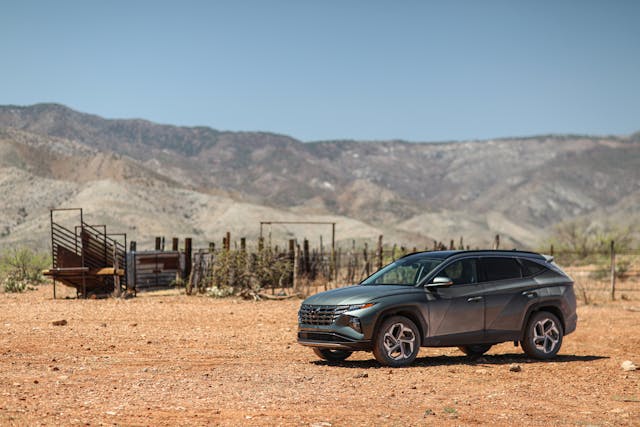
Hyundai also gave us the chance to take the Tucson over some dusty, gravel-strewn roads to see how it handles off-pavement. There wasn’t anything that would make a 4×4 pickup flinch, but it was exactly the kind of backcountry roads you’d encounter on an adventurous outing to a national park. You know the kind: graded, but rutted by the coarse tread of a massive tractor. These are the roads that shake you apart in an old Jeep at 15 mph and are much better traversed at 35 mph, which is how we handled it. If the Tucson had any rattles, they’ll need a lot more punishment to come loose. These roads were like driving on paint shakers, and the Tucson ate them up just fine. The only gripe we had was the occasional harsh feedback from the steering wheel when negotiating some of the bigger sandstone ruts, but we chalk that up to tires with a firm sidewall.
Our time with the Tuscon was, it should be noted, spent in high-end trim levels that came packed with all the available features. But even on the base SE models, which start at just over $26,000, including destination, Hyundai has added lots of safety features that customers demand, such as forward-collision warning and lane-keeping assist. Its feature-packed value combined with head-turning looks is something that should have Tucson’s competitors paying attention. We can hardly wait for this design language to make its way into the Veloster.
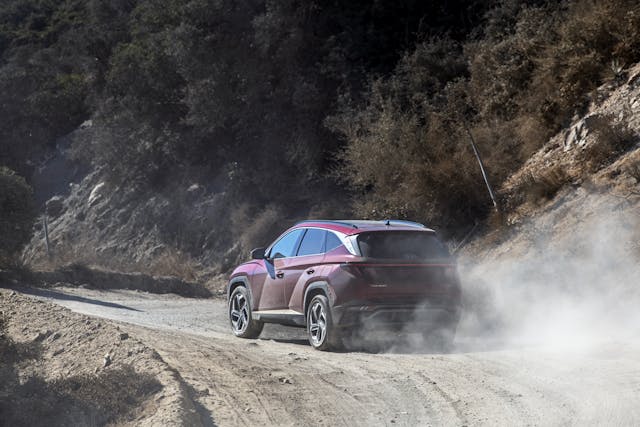
2022 Hyundai Tuscon
Highs: Roomy, hybrid has lots of low-speed torque, all models come with plenty of safety tech.
Lows: Large touchscreen interface without knobs or dials will annoy some.
Summary: Hard to go wrong with the 2022 Tucson if a basic crossover is what you need, especially if you don’t mind a futuristic-looking flavor.
